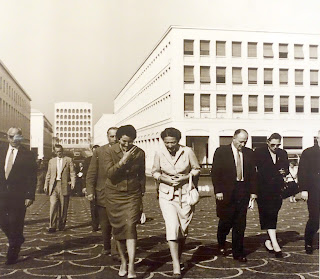There it was, on the horizon: an enormous cupola (dome), but belonging to what?
RST had rented a 9th-floor apartment in Ostiense, complete with terrace, where we spent many pleasant hours with our bicchieri of white wine,
taking in the view--including that cupola. In the photo below, the cupola is under the crane, at right.
One day in May we set out on foot to locate the building housing the cupola. Our journey took us through Garbatella (which we've written about extensively), then into the neighborhoods of the next jurisdiction--San Paolo.
San Paolo is large and diverse, home to the dramatic, reconstructed basilica,
San Paolo Fuori le Mura (Saint Paul outside the walls), and to new buildings of the Universita' degli Studi Roma Tre, which provides commercial energy to a few blocks. But on this occasion, our focus was singular: we just wanted to find that cupola.
On the way, we came across one interesting, older building: the Azienda Tramvie Autobus del Governatorato, on via Alessandro Severo.
The name on the building refers to an agency, created in 1927 under Mussolini's fascist regime. The agency was intended to develop and change Rome's system of trams and buses, and it did that, closing trams lines in the center and opening new ones on the periphery, including some in San Paolo. The building was basically a tram and bus barn. It opened in 1930 and was in use until 2003. It housed Rome's first electric tram cars.
The building was designed to be in the Liberty (art nouveau) style, and there are hints of that. But some of the Liberty elements proved too complex and expensive to produce, and the design was scaled back and simplified.
Something in the agency's name identified it with Fascism, and when the regime fell in 1944, the name was changed.

The facade includes two nice renderings of Rome's founding myth and symbol--
Romulus, Remus, and the She-wolf--here, embedded within an elaborate sculpture. .
A distraction from our quest: one of Rome's nasoni, painted in blues and reds.
And another distraction: an anti-theft device at the entrance to a private residence, rendered in modernist style:
Despite its prominence from a distance, the dome proved remarkably difficult to find and approach, perhaps because it's located on a hill with somewhat limited access. The photo below was taken from behind the structure.
Still, we persevered, and there it was: the Basilica di Santa Maria Regina degli Apostoli alla Montagnolo: Basilica of St. Mary Queen of the Apostles at Montagnolo (Montagnolo, likely named after the hill on which the basilica sits, is also the name of the Rome suburb--apparently a sub-division of San Paolo--in which it is located). The address is via Antonio Pio, 75.
Construction was to begin in 1943, but the war--especially the bombing of Rome--intervened, and no work was done until 1945. The church (designated a minor basilica in 1983) was completed in 1954. The architect was a native Roman, Leone Favini, who took his inspiration from the style of Roman baroque, but with a modern feel. Favini was one of several architects who worked on the Quartiere Ina-Casa Tuscolano I (a major public housing project) in the early 1950s.
In square feet of floor space, the structure isn't all that big. But because the dome is almost as tall as the church is wide, the volume of interior space is among the largest of Rome's churches. The dome is nothing short of spectacular.
The frescoes on the cupola, by A.G. Santagata, feature Mary seated among the apostles, as the Spirito Santo (the Holy Ghost) descends among them.
To get to the Basilica, take bus 715 from Teatro Marcello, or the Metro B to the San Paolo station, and walk.
For more on the structure--in English--try the website
http://romanchurches.wikia.com/wiki/Santa_Maria_Regina_degli_Apostoli_alla_Montagnola
Bill



















